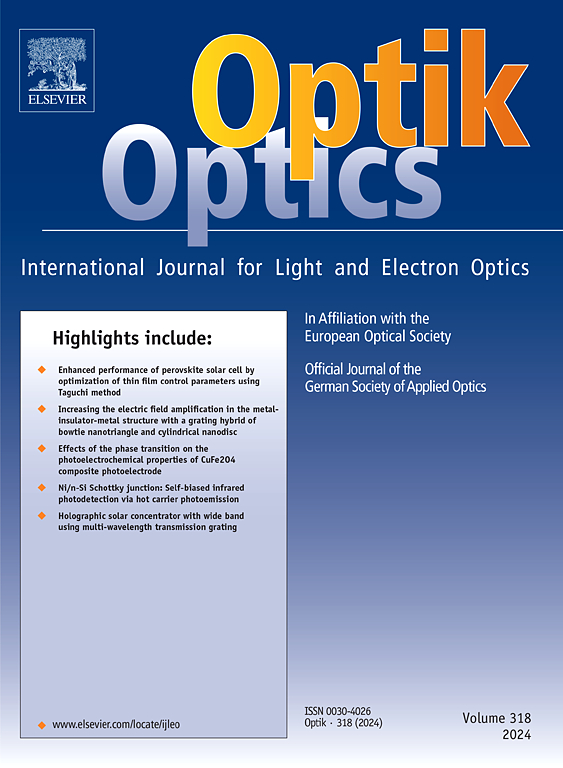Facile green synthesis of nickel oxide nanoparticles using Citrus medica leaf derivatives, characterization and study of dye degradation activity
IF 3.1
3区 物理与天体物理
Q2 Engineering
引用次数: 0
Abstract
The nanosized Nickel Oxide is competitive in the solar treatment of textile industry effluent, which is a significant cause of global water pollution. The Nickel Oxide was meticulously prepared to utilize a green synthesis methodology, thereby demonstrating remarkable photon absorption characteristics spanning the substantial solar spectrum, encompassing visible light regions. Subsequent investigations have revealed that the optical band gap of the material under scrutiny is measured to be 3.1 eV. Additionally, the structural analysis of Nickel Oxide nanoparticles has indicated that the average crystallite size is 12.1 nm. Morphological analysis reveals that rod-like Nickel Oxide nanoparticles were grown with a uniform particle distribution. Photoluminescence (PL) examination reveals the consequences of structural defects and oxygen-based deficiencies, which help to extend the life span of charge carriers’ recombination. X-ray Photoelectron Spectroscopy (XPS) - surface chemical state examinations confirmed various oxygen-coordinated molecular species accommodation. The dye degradation percentages of methylene orange and methylene violet organic dyes were observed to be 98 % and 94 %, respectively. These results were obtained by utilizing a bio nano-rod catalyst with a dose of 0.2 g/l during a 60-minute duration under solar light irradiation. According to the observations, it was demonstrated that the photodegradation of Methyl Orange dye solution by Nickel Oxide nanoparticles synthesized under a beneficial pathway using an ecological, benign process under favourable circumstances was successful. Comparatively, the Nickel Oxide was favourable to eliminating the Methyl Orange (MO) dye compositions utilizing the renewable light source under ecological and beneficial pathways.
利用柑橘叶衍生物合成易绿氧化镍纳米颗粒,对染料降解活性进行表征和研究
纳米氧化镍在纺织工业废水的太阳能处理中具有竞争力,纺织工业废水是全球水污染的一个重要原因。氧化镍经过精心制备,利用绿色合成方法,从而显示出跨越大量太阳光谱的显著光子吸收特性,包括可见光区域。随后的研究表明,该材料的光学带隙被测量为3.1 eV。此外,结构分析表明,氧化镍纳米颗粒的平均晶粒尺寸为12.1 nm。形貌分析表明,纳米颗粒呈棒状,颗粒分布均匀。光致发光(PL)检测揭示了结构缺陷和氧基缺陷的后果,有助于延长载流子复合的寿命。x射线光电子能谱(XPS) -表面化学状态检查证实了各种氧配位分子物种的适应。亚甲基橙和亚甲基紫有机染料的染料降解率分别为98 %和94 %。这些结果是通过使用剂量为0.2 g/l的生物纳米棒催化剂在太阳光照射下持续60分钟获得的。结果表明,在有利条件下,采用生态、良性的工艺,在有益途径下合成的氧化镍纳米颗粒光降解甲基橙染料溶液是成功的。相比之下,在生态和有益的途径下,氧化镍有利于利用可再生光源去除甲基橙(MO)染料成分。
本文章由计算机程序翻译,如有差异,请以英文原文为准。
求助全文
约1分钟内获得全文
求助全文
来源期刊

Optik
物理-光学
CiteScore
6.90
自引率
12.90%
发文量
1471
审稿时长
46 days
期刊介绍:
Optik publishes articles on all subjects related to light and electron optics and offers a survey on the state of research and technical development within the following fields:
Optics:
-Optics design, geometrical and beam optics, wave optics-
Optical and micro-optical components, diffractive optics, devices and systems-
Photoelectric and optoelectronic devices-
Optical properties of materials, nonlinear optics, wave propagation and transmission in homogeneous and inhomogeneous materials-
Information optics, image formation and processing, holographic techniques, microscopes and spectrometer techniques, and image analysis-
Optical testing and measuring techniques-
Optical communication and computing-
Physiological optics-
As well as other related topics.
 求助内容:
求助内容: 应助结果提醒方式:
应助结果提醒方式:


